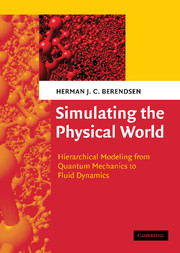Book contents
- Frontmatter
- Contents
- Preface
- Symbols, units and constants
- Part I A Modeling Hierarchy for Simulations
- 1 Introduction
- 2 Quantum mechanics: principles and relativistic effects
- 3 From quantum to classical mechanics: when and how
- 4 Quantum chemistry: solving the time-independent Schrödinger equation
- 5 Dynamics of mixed quantum/classical systems
- 6 Molecular dynamics
- 7 Free energy, entropy and potential of mean force
- 8 Stochastic dynamics: reducing degrees of freedom
- 9 Coarse graining from particles to fluid dynamics
- 10 Mesoscopic continuum dynamics
- 11 Dissipative particle dynamics
- Part II Physical and Theoretical Concepts
- References
- Index
10 - Mesoscopic continuum dynamics
Published online by Cambridge University Press: 05 June 2012
- Frontmatter
- Contents
- Preface
- Symbols, units and constants
- Part I A Modeling Hierarchy for Simulations
- 1 Introduction
- 2 Quantum mechanics: principles and relativistic effects
- 3 From quantum to classical mechanics: when and how
- 4 Quantum chemistry: solving the time-independent Schrödinger equation
- 5 Dynamics of mixed quantum/classical systems
- 6 Molecular dynamics
- 7 Free energy, entropy and potential of mean force
- 8 Stochastic dynamics: reducing degrees of freedom
- 9 Coarse graining from particles to fluid dynamics
- 10 Mesoscopic continuum dynamics
- 11 Dissipative particle dynamics
- Part II Physical and Theoretical Concepts
- References
- Index
Summary
Introduction
The term “mesoscopic” is used for any method that treats nanoscale system details (say, 10 to 1000 nm) but averages over atomic details. Systems treated by mesoscopic methods are typically mixtures (e.g., of polymers or colloidal particles) that show self-organization on the nanometer scale. Mesoscopic behavior related to composition and interaction between constituents comes on top of dynamic behavior described by the macroscopic equations of fluid dynamics; it is on a level between atoms and continuum fluids. In mesoscopic dynamics the inherent noise is not negligible, as it is in macroscopic fluid dynamics.
Mesoscopic simulations can be realized both with particles and with continuum equations solved on a grid. In the latter case the continuum variables are densities of the species occurring in the system. Particle simulations with “superatoms” using Langevin or Brownian dynamics, as treated in Chapter 8, are already mesoscopic in nature but will not be considered in this chapter. Also the use of particles to describe continuum equations, as in dissipative particle dynamics described in Chapter 11, can be categorized as mesoscopic, but will not be treated in this chapter. Here we consider the continuum equations for multicomponent mesoscopic systems in the linear response approximation. The latter means that fluxes are assumed to be linearly related to their driving forces. This, in fact, is equivalent to Brownian dynamics in which accelerations are averaged-out and average velocities are proportional to average, i.e., thermodynamic, forces.
- Type
- Chapter
- Information
- Simulating the Physical WorldHierarchical Modeling from Quantum Mechanics to Fluid Dynamics, pp. 297 - 304Publisher: Cambridge University PressPrint publication year: 2007



